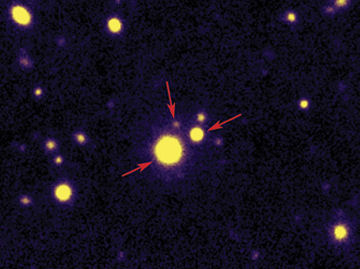Astronomers have discovered the first example of a trio of quasars, the brilliant beacons of light that seem to be fueled by supermassive black holes at the centers of galaxies. The triplet adds to earlier evidence that supermassive black holes and galaxies grow in lockstep.

George Djorgovski of the California Institute of Technology in Pasadena and his colleagues began their study by examining a distant quasar called LBQS 1429-008. Another team had found the quasar in 1989 and soon after detected a nearby spot that could have been either a companion quasar or a cosmic mirage. According to Einstein’s general theory of relativity, the gravity of a massive foreground galaxy can act as a lens, splitting the light from a background body, such as a quasar, into two or more images.
In the new work, Djorgovski’s team analyzed images of the quasar and its surroundings taken at two telescopes. The images revealed a second, even fainter potential companion to LBQS 1429-008.
The team initially proposed that both of the nearby spots were optical illusions generated by the gravity of a foreground galaxy. But the researchers couldn’t find any such galaxy. Computer modeling revealed that gravitational lensing couldn’t plausibly account for the brightness and geometry of the three quasar images.
Instead, the triple images almost certainly represent three distinct but closely spaced quasars about 10.5 billion light-years from Earth, Djorgovski reported last week at a meeting of the American Astronomical Society in Seattle. Scientists have occasionally found two quasars in the same vicinity, he notes, but “to find three is unprecedented.”
At the Seattle meeting, theorist Fred Rasio of Northwestern University in Evanston, Ill., described new simulations of the interactions of three closely spaced supermassive black holes. His team finds that when a third black hole meets up with two already orbiting each other, one of the trio tends to get kicked out of the system while the other two orbit more closely, hastening their eventual merger.
Of the three black holes powering the quasars in Djorgovski’s study, two will probably coalesce in about 100 million years, Rasio says.
The tight grouping of these three quasars indicates that their host galaxies must be in the early stages of merging, Djorgovski suggests. He notes that the separation among the quasars, about 100,000 light-years, is a distance typical of interacting galaxies.
Galaxy mergers are less common today than during the early era from which the triplet quasars hail—about 3 billion years after the Big Bang. Since than, the expansion of the universe has pushed galaxies farther apart.
Over the past few years, astronomers have accumulated evidence that the mass of stars surrounding a galaxy’s center is always about 1,000 times the mass of the galaxy’s supermassive black hole (SN: 1/22/05, p. 56: Available to subscribers at The Hole Story). If two of the three galaxies ultimately merged, that interaction would funnel gas to the central black holes, increasing their girth, says Rasio. This would enhance quasar activity, which in turn would influence the star-formation rate in the galaxy’s core.







